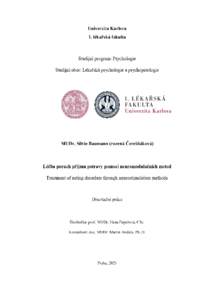Léčba poruch příjmu potravy pomocí neuromodulačních metod
Treatment of eating disorders through neurostimulation methods
dissertation thesis (DEFENDED)

View/
Permanent link
http://hdl.handle.net/20.500.11956/152559Identifiers
Study Information System: 177938
Collections
- Kvalifikační práce [4588]
Author
Advisor
Consultant
Anders, Martin
Referee
Ustohal, Libor
Stárková, Libuše
Faculty / Institute
First Faculty of Medicine
Discipline
Medical Psychology and Psychopathology
Department
Department of Psychiatry First Faculty of Medicine Charles University and General University Hospital in Prague
Date of defense
5. 10. 2021
Publisher
Univerzita Karlova, 1. lékařská fakultaLanguage
Czech
Grade
Pass
Keywords (Czech)
anorexie, bulimie, elektrokonvulzivní terapie, hluboká mozková stimulace, neuromodulace, psychogenní přejídání, repetitivní transkraniální magnetická stimulace, stimulační metody, transkraniální stimulace stejnosměrným proudemKeywords (English)
anorexia, binge-eating, bulimia, electroconvulsive therapy, deep brain stimulation, neuromodulation, repetitive transcranial magnetic stimulation, stimulation methods, transcranial direct current stimulationÚvod: Poruchy příjmu potravy patří k obtížně léčitelným psychiatrickým onemocněním, u nichž často selhávají klasické postupy léčby. Ve své práci uvádím přehled základních stimulačních metod a jejich použití v léčbě mentální anorexie (AN), mentální bulimie a psychogenního přejídání. Praktická část byla zaměřena na hodnocení účinnosti léčby AN pomocí transkraniální stimulace stejnosměrným proudem (tDCS). Jedná se o randomizovanou, dvojitě zaslepenou a placebem kontrolovanou studii. 43 pacientů s AN bylo rozděleno a stimulováno buď aktivní (A) tDCS =21). Stimulován byl levý dorzolaterální prefrontální kortex (anoda na sytému 10 20, katoda na pravý orbitofrontální region Délka stimulace byla každý všední den po dobu 2 týdnů (10 stimulací) o intenzitě 2 mA. Všichni pacienti před i po stimulaci dotazník EDE Q, Zungovu sebeposuzovací škálu deprese, byli zváženi, byl jim monitorován termální práh bolesti a porucha vnímání vlastního těla pomocí počítačového programu Anamorfic. Po 2 a 4 týdnech bylo kontrolováno BMI pacientů, EDE Hodnocení proběhlo pomocí statistických metod ANOVA a OPLS. Výsledky: obou skupinách došlo v průběhu sledování k nárůstu BMI a celkově ke klinickému zlepšení specifické psychopatologie (EDE Q), ale výsledky nedosáhly statistického významu. Ve skupině A došlo mezi 1. a 4. kontrolou ke snížení...
Background: Eating disorders are psychiatric illnesses whose treatment is difficult and usually the classic procedures fail. Recently, the number of researches in neuromodulatory methods has increased. I present an overview of basic stimulation methods, their use in the treatment of anorexia nervosa (AN), bulimia nervosa and binge-eating and the results of our study focused on the treatment of AN by transcranial direct current stimulation (tDCS). Methods: It was a randomized, double-blind, sham-controlled trial. Forty-three inpatients with AN were divided to receive either active (n=22) or sham (n=21) tDCS over the left DLPFC (anode F3/cathode Fp2, 2mA for 30 minutes). All patients filled the Eating Disorder Examination Questionnaire (EDE-Q) and Zung depression scale (ZUNG), we measured them the thermal pain threshold, the objective dissatisfaction with their own body by Anamorfic program and evaluated BMI before the first and after the last tDCS. Follow-up was after 2 and 4 weeks. It was evaluated using ANOVA and OPLS model. Results: Compared to sham tDCS, active tDCS improved self-evaluation based on one's body shape (p < 0,05) and significantly decreased the need of excessive control over calorie intake (p < 0,05) in 4-week follow-up (questions 4 and 23 in EDE-Q). Question 21 in EDE-Q was more...
